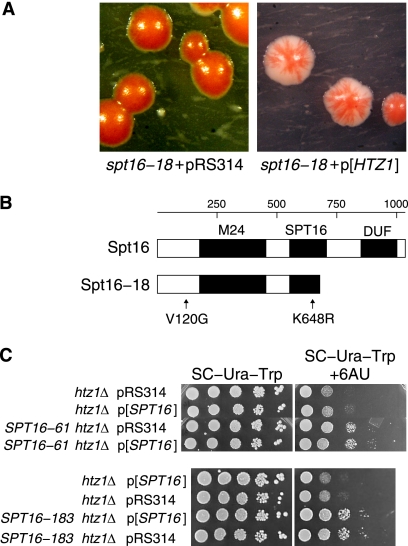Fig. 3.
Alleles of SPT16 genetically interact with htz1Δ. (A) The SPT16-18htz1 allele is dominant synthetic lethal with htz1Δ. Colonies of the SPT16-18/SPT16htz1 htz1Δ/htz1Δ (MSY2464) double mutant are nonsectoring, indicating that the cells require wild-type HTZ1 contained in the ADE3 plasmid to grow (left). Introduction of HTZ1 on a CEN ARS TRP1 plasmid restores sectoring in the double mutant (right). (B) Schematic of the functional domains of the yeast Spt16 protein and the predicted Spt16-18 mutant protein showing the sites of mutation. M24, peptidase M24 motif (InterPro IPR000994); SPT16, Spt16 motif (InterPro IPR013953); DUF, domain of unknown function (InterPro IPR013719) shared with Rtt106 and other histone chaperones. (C) Alleles of SPT16 suppress the 6-AU sensitivity of htz1Δ. (Top) The poor growth of the htz1Δ strain on media containing 6-AU is suppressed in the SPT16-61 htz1Δ strain, and the introduction of wild-type SPT16 on a pRS314-SPT16 plasmid (p[SPT16]) does not reverse the suppression. Growth is shown after 4 days. htz1Δ pRS314, MSY4002; htz1Δ p[SPT16], MSY4003; SPT16-61 htz1Δ pRS314, MSY3973; SPT16-61 htz1Δ p[SPT16], MSY3974. (Bottom) Similar results are shown for SPT16-183. SPT16-183 htz1Δ pRS314, MSY3979; SPT16-183 htz1Δ p[SPT16], MSY3980; other strains are as above.

